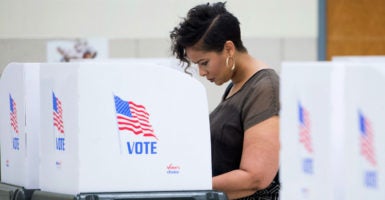An upset victory by Donald Trump last week has pollsters, politicians, and Americans in general wondering where Trump’s supporters, who swept him to victory in 29 states with 290 electoral votes, ever came from.
The results in some cases have differed widely from what the polls were predicting. At the moment, we only have exit polls from the National Election Pool to go from, but in the context of similar exit polls from 2012 (see also The New York Times’ reporting), these data can shed some light on an electoral outcome that for many was completely unexpected.
1. The gender gap widens—but not because Trump lost women.
Some expected Trump to take big hits among women. The main question leading into the election was, how extensive would the damage be?
While Trump did receive a slightly smaller portion of the female vote than Mitt Romney in 2012 (42 percent, down from Romney’s 44 percent), this was little more than a blip.
Despite his unexpectedly strong performance among women, the gender gap still widened considerably as Trump won a substantially larger portion of men than Romney won in 2012. Trump won 53 percent of men to Hillary Clinton’s 41 percent—a 12-point spread. By comparison, Romney only won men by 7 points in 2012.
2. Trump holds his ground among young millennials.
President Barack Obama’s 2008 campaign was known in part for energizing millennial voters, who typically vote at lower rates than older voters.
Obama carried 66 percent of the 18-29 age cohort that year. But this effect began to dissipate in the 2012 election, as Obama lost the white millennial vote to Romney.
This year, Trump largely maintained that hold, carrying 48 percent of the white 18-29 vote—a five-point lead over Clinton. Despite minor fluctuations among the older generations, the age breakdown among Trump voters is similar to that of Romney voters.
Clinton, on the other hand, was less effective than even Obama’s second campaign at garnering support among the 18-29 crowd. As a result, the wide age gap begun in the 2004 election has continued to close, as Trump held steady among millennials and Clinton lost her grip on the promising demographic.
3. What Latino backlash?
If the 2008 turnover of presidential power was a story of the black vote, the 2016 race was expected to be a story about the Latino vote.
Multiple outlets, including The New York Times and The Atlantic, were predicting that Trump had alienated—perhaps permanently—Latino voters across the country, spelling disaster for his campaign and possibly the Republican Party far into the future.
However, this mass alienation of Latinos failed to materialize, as Trump actually performed marginally better than Romney among both Latinos and blacks, gaining in both groups by two points. This paved the way for Trump’s victory in the swing state of Florida.
4. Socioeconomic trends continue—but to a lesser degree.
The voting trend in recent elections has been one of Democrats gaining among lower-income voters, and Republicans gaining among higher-income voters.
This election saw a continuation of that trend, as Democrats captured the majority of voters making less than $50,000 (52 percent) and Republicans carried the majority of voters making over $50,000 (49 percent).
But notably, this trend was softened by gains Trump made among those making under $30,000 (+6 percent) and losses among those making over $50,000 (-4 percent). This is one small indication of the unusual effect Trump has had among blue-collar voters.
This effect is made even plainer when dissecting education level. Unlike the income trend above, the education trend occurring within the Republican Party actually strengthened with Trump, as he won a greater percentage of those with less than a college degree (52 percent, up five points from Romney’s 47 percent) and continued to lose ground among those with more education (43 percent, down five points from Romney’s 48 percent).
The shifts made by Trump in both income and education levels mark the largest demographic shifts of the 2016 presidential election.
5. The rural vote surges.
The regional breakdown is enjoying an unusual place in the spotlight this election, as commentators focus on the unexpectedly high turnout among rural voters. Regional data was reported differently last year, so direct year-to-year comparisons are unavailable.
That Trump had such an advantage in rural areas (62 percent over Clinton’s 34 percent) is not so surprising. What is surprising is how wrong so many polls proved to be.
Part of this surprise came from flawed polling models derived from the 2012 electoral makeup. Rural turnout in 2012 was exceptionally low, and this year’s soaring rural turnout likely contributed to the overall havoc wreaked on this year’s polling models.
































